Related Research Articles

Ludo is a strategy board game for two to four players, in which the players race their four tokens from start to finish according to the rolls of a single die. Like other cross and circle games, Ludo is derived from the Indian game Pachisi. The game and its variations are popular in many countries and under various names.
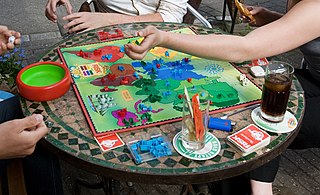
Risk is a strategy board game of diplomacy, conflict and conquest for two to six players. The standard version is played on a board depicting a political map of the world, divided into 42 territories, which are grouped into six continents. Turns rotate among players who control armies of playing pieces with which they attempt to capture territories from other players, with results determined by dice rolls. Players may form and dissolve alliances during the course of the game. The goal of the game is to occupy every territory on the board and, in doing so, eliminate the other players. The game can be lengthy, requiring several hours to multiple days to finish. European versions are structured so that each player has a limited "secret mission" objective that shortens the game.
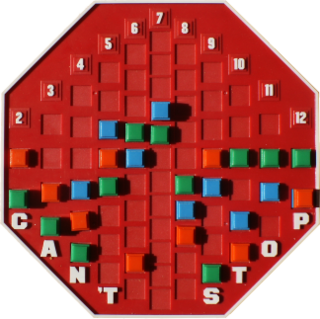
Can't Stop is a board game designed by Sid Sackson originally published by Parker Brothers in 1980; however, that edition has been long out of print in the United States. It was reprinted by Face 2 Face Games in 2007. An iOS version was developed by Playdek and released in 2012. The goal of the game is to "claim" three of the columns before any of the other players can. But the more that the player risks rolling the dice during a turn, the greater the risk of losing the advances made during that turn.
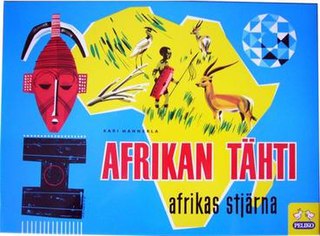
Afrikan tähti, known in Swedish as Den försvunna diamanten or Afrikas stjärna, is a Finnish board game designed by Kari Mannerla originally in 1951. It has been one of the most popular board games in the Nordic countries for decades.

The Russian Campaign is a strategic board wargame published by Jedko Games in 1974 that simulates combat on the Eastern Front during World War II. Avalon Hill later bought the game and produced several editions.
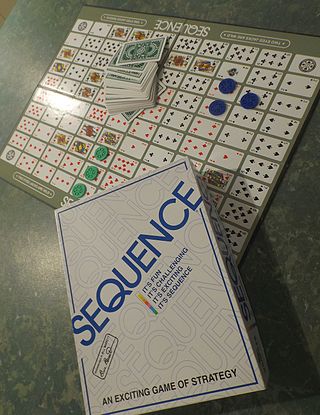
Sequence is an abstract strategy tabletop party game. Sequence was invented by Douglas Reuter and Hamish. They originally called the game Sequence Five. He spent years developing the concept, and, in June 1981, granted Jax Ltd. an exclusive license to manufacture, distribute and sell the board game Sequence and its subsequent variations. The game was first sold in a retail store in 1982. In 2017, Goliath Game Company bought Jax, and in early 2018 also bought all licensor rights and now owns 100% of the game Sequence. Doug Reuter is acknowledged as the inventor of Sequence on all newly produced copies of the game - both on the box and in the printed rules.

War at Sea is a strategic board wargame depicting the naval war in the Atlantic during World War II, published by Jedko Games in 1975, and subsequently republished by Avalon Hill in 1976 and more recently by L2 Design Group in 2007.
Dice chess can refer to a number of chess variants in which dice are used to alter gameplay; specifically that the moves available to each player are determined by rolling a pair of ordinary six-sided dice. There are many different variations of this form of dice chess. One of them is described here.

Arkham Horror is a cooperative adventure board game designed by Richard Launius, originally published in 1987 by Chaosium. The game is based on Chaosium's roleplaying game Call of Cthulhu, which is set in the Cthulhu mythos of H.P. Lovecraft and other horror writers. The game's second edition was released by Fantasy Flight Games in 2005, with a third edition in 2018.
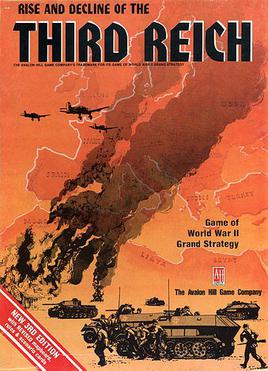
Rise and Decline of the Third Reich or more commonly Third Reich is a grand strategy wargame covering the European theater of World War II, designed by John Prados and released in 1974 by Avalon Hill. Players take on the roles of major powers—Germany, Italy, United Kingdom, France, the Soviet Union, and the United States—from 1939 to 1946.
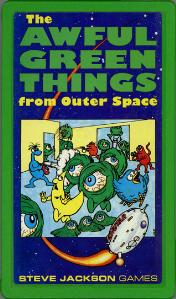
The Awful Green Things from Outer Space (AGTFOS) is a two-player space combat board game developed and illustrated by Tom Wham.

Aeroplane chess is a Chinese cross-and-circle board game similar to the Western game of Ludo and the Indian game of Pachisi. Developed in the 20th century, aeroplane chess features airplanes as pieces instead of the more abstract pawns and beehive-shaped pieces found in the games from which it is derived. Aeroplane chess has spread around the world, especially in Africa.
Bookchase is a 2007 board game published by Art Meets Matter. Players compete to acquire six small books for their bookshelf. They do this by partly by answering multiple-choice questions, partly by visiting special spaces on the board: The Bookshop, The Book Corner, The Library and also by chance events triggered by the turn of an Award or Sentence card.
A number of related games under the Yahtzee brand have been produced. They all commonly use dice as the primary tool for game play, but all differ generally. As Yahtzee itself has been sold since 1954, the variants released over the years are more recent in comparison, with the oldest one, Triple Yahtzee, developed in 1972, eighteen years after the introduction of the parent game.

RoboRally is a board game for 2–8 players designed by Richard Garfield and published by Wizards of the Coast (WotC) in 1994. Various expansions and revisions have been published by both WotC and by Avalon Hill.

Speed Circuit is a Formula I racing game published by 3M in 1971, and then republished by Avalon Hill in 1977.
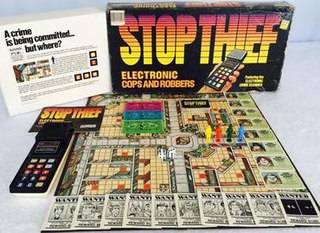
Stop Thief is an American-originated electronic board game published by Parker Brothers. It was released in 1979. In 2016, Restoration Games announced that they were bringing back a restored version of the game, using a free smartphone companion app in place of the electronic device. On April 11, 2017, they successfully funded a Kickstarter campaign for the game.
Sho is a traditional race game in Tibet, still common today. Its name is simply the Tibetan word for "dice". It is traditionally played for money and by men, with two to four players - three being the most common. With four players, the usual variant is to play as two teams of two, with the partners sitting opposite each other.

King of Tokyo is a tabletop game using custom dice, cards, and boards, designed by Richard Garfield and released in 2011. A New York City-based edition, King of New York, was published in 2014. The game was re-released in 2016, with all-new artwork and characters.

Wizard's Quest is a fantasy board wargame published by Avalon Hill in 1979.
References
- 1 2 3 4 Diffell, Caleb (2005-08-21). "Hexagony". The Games Journal. Retrieved 2020-07-29.
- 1 2 3 Tomashow, Mitch (2002). "Bin'Fa". The Game Journal. Retrieved 2020-07-29.
- 1 2 3 Levy, Herb. "Bin'Fa: The Tao of War". gamersalliance.com. Retrieved 2020-07-29.
- 1 2 Taylor, Stephen (November 1980). "Capsule Reviews". The Space Gamer . Steve Jackson Games (33): 29.
- ↑ "GAMES Magazine #26". November 1981.
- ↑ "GAMES Magazine #33". November 1982.
- ↑ "Games and Puzzles magazine | Wiki | BoardGameGeek".